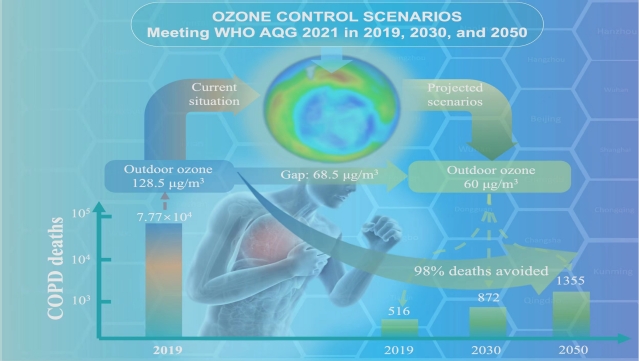
Highlights
COPD deaths attributable to indoor and outdoor ozone were estimated.
Three control scenarios to meet WHO AQG 2021 in different year were considered.
98% of COPD deaths could be avoided by reducing ozone to WHO AQG 2021 level.
Indoor ozone sources contribute less than 5% of COPD deaths.
Population growth and aging increase the urgency of ozone control.
Abstract: Chronic obstructive pulmonary disease (COPD) is an epidemic in China. Ozone is a possible risk factor of COPD, with ozone concentrations increasing in China despite air pollution mitigation measures that reduced particulate matter. The WHO Air Quality Guidelines (AQG) recommendations in 2021 is a turning point that formally recognizes the crucial role of indoor air pollution. We aimed to investigate the premature COPD deaths attributable to ozone in 2019, taking the WHO AQG 2021 level into account to determine the gap to bridge ozone control in China. First, we assessed ozone exposures initiated from indoor and outdoor sources by gender and age groups in 344 cities under four scenarios: 2019 as a baseline, and outdoor ozone at WHO AQG 2021 level in 2019, 2030, and 2050, respectively. Subsequently, we estimated COPD deaths attributable to ozone. The results show that the COPD deaths attributable to ozone are 77 737 in 2019, and 527, 872, 1355 if the outdoor ozone concentration is reduced to the WHO AQG 2021 level in 2019 (counterfactual scenario), 2030, and 2050, respectively in urban China. The indoor ozone sources only contribute to less than 5% of COPD deaths. A gap of 68.5 μg/m3 for the highest seasonal ozone concentration should be bridged to meet the WHO AQG 2021 and avoid over 76 thousand (98%) COPD deaths in 2019 in urban China.
Keywords: Ozone; Environmental risk; Respiratory disease; Exposure; Mortality; Air Quality Guidelines
DOI: 10.1016/j.eehl.2022.11.002